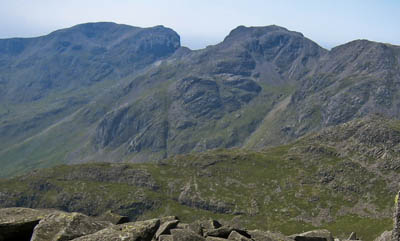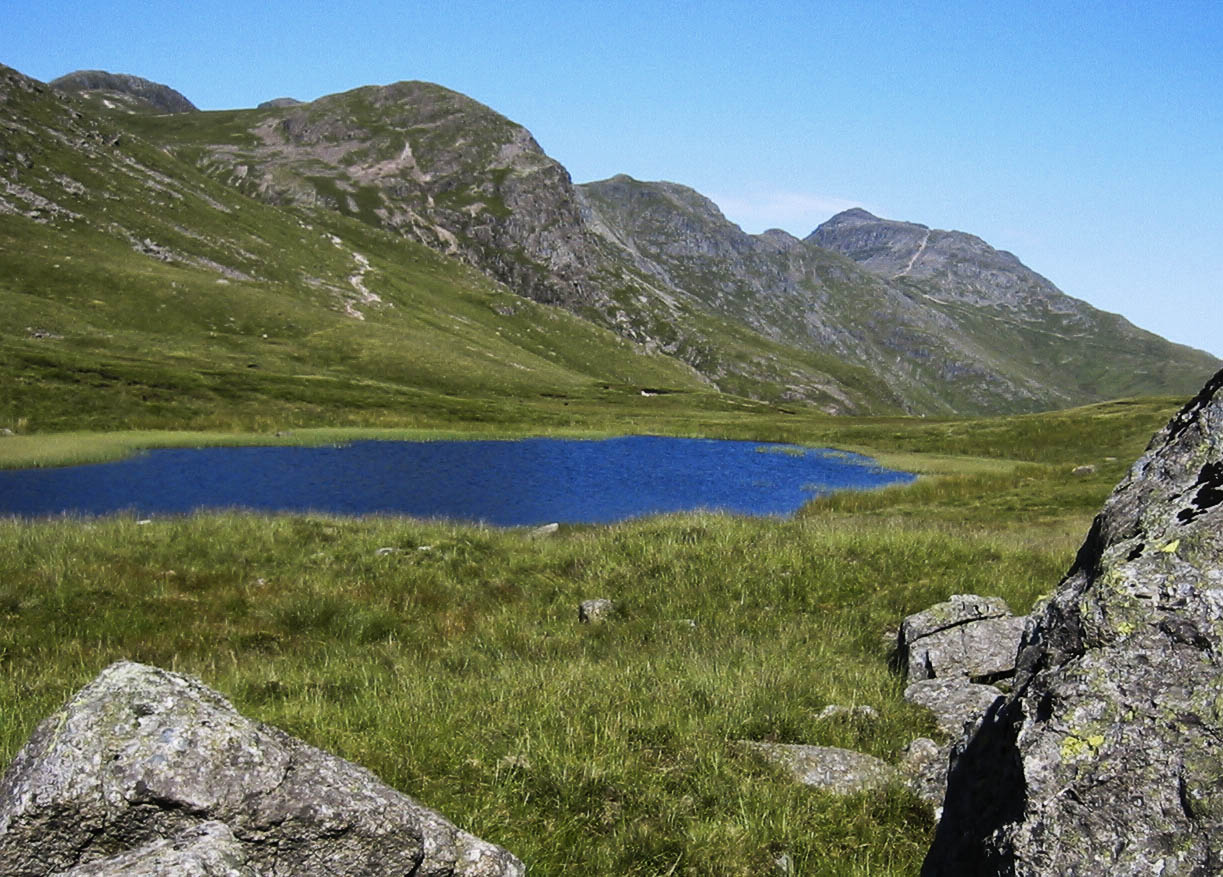 Mountain celebrities oppose the idea of introducing safety measures on Britain’s mountains.
Mountain celebrities oppose the idea of introducing safety measures on Britain’s mountains.
Everest veteran Sir Chris Bonington is among those dismissing fixing permanent protection on routes, following the latest death in the Lake District.
Scafell, left, and Scafell Pike, separated by Mickledore
In fact, it’s not easy to find anyone who is in favour of such impositions, other than a journalist from a Cumbrian newspaper who had the bright idea of asking if they were needed.
Julian Carradice, leader with the Wasdale Mountain Rescue Team, told the North-West Evening Mail that ‘mountaineers wouldn’t want to see iron ladders going up on the fell tops.’ However, Mr Carradice, whose team went to the aid of mountaineer David Woodland after his fatal fall on Broad Stand, said there was a case to be made for putting signs at the start of difficult routes.
But, he said, no amount of safety measures on the fells would make a difference. He told the newspaper that he could mark with an X the point where walkers land after coming off Broad Stand.
Bonington, whose Caldbeck home is on the fringe of the Lake District, said: “People who choose the Broad Stand route should know they are heading for a scramble.
“Better information is one thing but having ropes or stanchions put in would jeopardise the mystery and romance of climbing in the fells. It would be the thin end of the wedge.”
Penrith climbing legend Doug Scott agreed. He told the Mail: “If you want to practise climbing then use an indoor wall.
“The outdoors is not for the unprepared and safety measures of any kind would probably backfire as more people come and have a go.
“People are responsible for their own well being and the health-and safety-culture should stay in urban areas where it was dreamt up and belongs.”
Ambleside-based mountaineer Tony Greenbank told the newspaper: “The last thing we should do is manicure our mountains.
“That will only encourage more of the ‘mobile phone’ generation to have a go at climbs they aren’t prepared for. If we had ladders and ropes put in all over the place, we would see more accidents not less.”
The only place in Britain with a fixed via-ferrata-type climbing route is the commercially run Fleetwith Pike installation, which has guides leading paying parties up the side of the crag above Honister slate mines.
Broad Stand provides a problem for many fellwalkers, coming, as it does between England’s highest and second-highest peaks. There is no trouble-free route between the two summits. A walker arriving at Mickledore, the couloir between the two, has a choice of the scramble up Broad Stand, a risky ascent of Lord’s Rake, which has a precariously balanced unstable chock stone at its head, or the slightly longer route via Foxes Tarn. Even this route, up a wet gully on the Eskdale side of the fell, had a reported rockfall last year.
There have been two fatalities within the last year on Broad Stand, and numerous callouts to walkers using the Lord’s Rake-Deep Gill route.
Less than a fortnight ago, Dave Allen, chairman of Mountain Rescue (England and Wales) was quoted as blaming the popularity of television series such as the Julia Bradbury presented Wainwright’s Walks for coaxing unprepared walkers on to the fells.
He said: “People with no experience have been attracted to often tricky mountains by programmes like Wainwright’s Walks.
“They are going out ill equipped and under prepared, and dialling 999 on their mobiles at the first sign of difficulty.
“In the majority of cases, the most basic grasp of how to read a map or understand the changeable nature of mountain weather conditions would have saved the rescue teams from having to go out.”
 Earlier this year, Langdale and Ambleside Mountain Rescue Team were called out twice to Crinkle Crags to rescue lost walkers. A spokesman for the team recalled the operation: “A man reported his two companions as suffering from hypothermia on the summit of Crinkle Crags. A search was organised, because he was uncertain exactly where they were, which is no surprise, as they were eventually located on Bowfell.
Earlier this year, Langdale and Ambleside Mountain Rescue Team were called out twice to Crinkle Crags to rescue lost walkers. A spokesman for the team recalled the operation: “A man reported his two companions as suffering from hypothermia on the summit of Crinkle Crags. A search was organised, because he was uncertain exactly where they were, which is no surprise, as they were eventually located on Bowfell.
“A combination of poor judgement, poor equipment, and poor navigation combined to cause this incident.”
A similar incident occurred 11 days later in which, as the team said, ‘Sometimes you go up one mountain and by some quirk of fate, accidentally climb another’. Kendal and Wasdale teams helped in the two searches, as did Search and Rescue Dogs.
Paradoxically, Wainwright himself was a notoriously cautious navigator, urging that many routes should not be tackled in mist or bad visibility. But there is a modern trend to play down or even deny the risks Britain’s mountains pose to the unwary and unprepared. It’s a risk that, sadly, becomes all too obvious when fatalities occur.
Yet it is part and parcel of the attraction of the fells, crags and mountains of our land that there is an element of danger in them, whether it is from the weather, the terrain or both.
Better training and mountain knowledge seems to be the key. Late last year, mountain rescuers decided to launch a campaign to raise public awareness about how mountain rescue works, with the aim of reducing the number of ‘guiding’ callouts. Walkers, and climbers, need to know a little more about the outdoors, the risks, what mountain rescue is and what it is not, they decided.
The campaign is due to be launched in the spring. 2007 was mountain rescue’s busiest year and this year is shaping up to be even busier.
In the meantime, perhaps the most important piece of information from the rescuers needs to be reinforced: ‘be prepared to swallow your pride: turn back if necessary, and be governed by the weakest party member’.
Anonymous
22 February 2008The tragic accident on Broad Stand at the weekend was just that. The group were all experienced fell walkers, who loved their weekends walking together, but were also aware of the risks involved. They were always correctly dressed and equipped and several of the party had mountain leader qualifications, with excellent navigation skills and mountain knowledge. My deepest sympathy goes to the family of David Woodland and to all those who lost a great friend on that fateful day.
Bill Pattison M.B.E.
01 March 2008[As leader of Wasdale M.R.T. for 22years i have seen too many fatalities many on Broad Stand not comment on the present problems facing rescue teams .The chairman of M.R.C.apparently stated that I wished to see a bolt placed on the top of Napes Needle but that is not so.What I have always maintained is that if The Needle or Broad Stand had been in the Alps then they certainly would have had fixed protection.The word ethics is used whenever the bolt issue is raised.I would ask which is preferable ,a bolt or a death ? What is needed is a sensible discussion between the responsible bodies to try and come to a sensible and acceptable solution.Sadly I doubt this would be possible if the Sergeant Slabs saga is anything to go by.More public awareness of the possible hazards facing people who visit the fells is necessary,Perhaps some hazard warning signs at main approach points would help.73 %Of persons requesting help from the Wasdale Team last year were incapable of navigating their way off the fell and a large percentage were also badly equipped,we need to get the message across that mobiles phones will not necessarily get you out of trouble and that M.R.is not the local branch of Tesco.The park authorities need to take a stance on 3Peakers ,you cant complain about footpath erosion and allow thousands to trample the fells to dirt tracks in the name of charity.The nimby attitude of fellgoers amazes me, they are quite happy to pull on any bit of foreign gear they see or fix thousands of metres of fixed ropes up some Tibetan Peak but a life saving bolt in the Lakes, no chance. These are entirely my own thoughts and should not be construed as representing Wasdale MRT. Bill Pattison M.B.E. Hon President
Tim
12 March 2008Bill, you can put all the bolts you like onto the hills but (a) people will still have to carry the equipment to attach themselves to the protection and, crucially, (b) know how to use it. Given that many people lack basic navigation skills, how likely is that? Better education in Hill Skills, beginning at school is the answer. And we need to find some way of addressing the Health and Safety issues that are preventing more and more teachers and scout/guide groups from venturing out.
Bill Pattison.M.B.E.
12 March 2008[color=#000000][/color]Points noted Tim but sadly some kids leave school unable to read and write properly .I doubt if this government would be willing to find the time and resources to allow them to learn basic fell skills ,witness the demise of so many outdoor centres.Sadly also some well intentioned but totally incompetent teachers ,scout and other leaders who should never have been allowed to take parties on the hills surely contributed to the state of play re Health and Safety today.In this litigation mindset we have I doubt there is little chance of progress without further certification of people who are willing and able to give their time to help young people enjoy the great outdoors safely.
Tim
15 March 2008Talking of litigation, suppose someone was injured as a result of one of these bolts failing? Lawyers to stand-by. I'm waiting for someone to sue the Park Authorities as a result of slipping on one of the staircases they have built all over the place - it's only a matter of time [smiley=sad]
Bill Pattison M.B.E.
17 March 2008[color=#000000][/color]Who would they sue if a natural anchor failesd ? In almost 60 years of climbing all over the world I have not seen or heard of a bolt failing,the people who place them in my experience tend to take responsible maintenance and replace as necessary.I dont recall any lawyer becoming rich as a result of claims. I agree some of the structured paths are unsafe to walk down and have made my views known to the park authorities but in fairness whats the alternative ? Brown Tongue for example ,fifty years ago a grassy slope ,30 years later it resembled the M6 with multiple paths an d terrible scarring.We could learn a lot from other countries re path (and road ) construction.